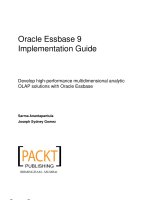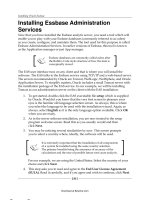Oracle Essbase 9 Implementation Guide- P38 pptx
Bạn đang xem bản rút gọn của tài liệu. Xem và tải ngay bản đầy đủ của tài liệu tại đây (733.42 KB, 5 trang )
Calculating your Essbase Cube
[ 170 ]
Do this instead:
FIX(@IDESCENDANTS("Calendar Periods" AND
@LEVMBRS("Calendar Periods",0))
Any Calculation Function;
ENDFIX
In the following examples, we will show you how to narrow down the amount
of data you will calculate in your database for various scenarios.
Basic FIX and ENDFIX examples
To begin with, as mentioned earlier, FIX and ENDFIX commands can be nested. We
have also given you some tips regarding when to use the FIX and ENDFIX commands
and what to avoid when nesting them, like the same dimensions named in separate
FIX commands.
For starters, this is how you would code the simplest of
FIX and ENDFIX commands:
FIX(@IDESCENDENTS("Calendar Periods"))
"Gross Stock" = "Production" – "Sales";
ENDFIX
Notice how the FIX command has an area to list selection dimensions. Within the
parenthesis you can list multiple dimension names separated by commas, member
names, or a list of member functions that returns member names. There are also
functions that return members at specic levels in the outline. You can even use basic
structuring similar to a mathematical formula with AND/OR statements bracketed by
extra parenthesis.
In the example immediately above, notice how we are calculating the value for
Gross Stock for all Calendar Periods. If your database was extremely large, with
several years of historical data in it, this would be inefcient to always calculate the
entire Time dimension.
Now, suppose you added User Dened Attributes (UDAs) to the periods in the time
dimension and only wanted to calculate current periods? Here is what you would do:
1. Add UDAs of Historical, Current, and Forecast to the individual year
members and their children in the database outline. For example, if the
current calendar year is 2009, then 2009 and all of its children would have
the UDA of Current added to them in the outline. All years and their
children prior to 2009 would get the UDA of Historical. All years and their
children later than 2009 would get the UDA of Forecast added in the outline:
This material is copyright and is licensed for the sole use by Paul Corcorran on 5th July 2009
8601 ave. p #1, , lubbock, , 79423
Download at Boykma.Com
Chapter 5
[ 171 ]
2. Decide that you only want to calculate Gross Stock for the Current
and Forecast time periods.
3. Recode your FIX and ENDFIX command statements to look like this:
FIX(@UDA("Calendar Periods","Current") OR
@UDA("Calendar Periods","Forecast"))
"Gross Stock" = "Production" – "Sales";
ENDFIX
Aren't FIX and ENDFIX commands the greatest?
Always remember with FIX and ENDFIX, you
want to Fix on Sparse dimensions and IF on
Dense dimensions.
EXCLUDE/ENDEXCLUDE
Well there you have it! With the release of Essbase version 9.x we now have EXCLUDE
and ENDEXCLUDE commands to compliment the FIX and ENDFIX commands.
Now, without confusing you, we can tell you to consider the
FIX and ENDFIX
commands as an include statement that tells Essbase what data to keep for calculating.
And, if including data proves difcult (and there are times it will), then you now have
the EXCLUDE and ENDEXCLUDE commands to tell Essbase what data to leave out when
selecting data for calculating. See examples in the next section.
This material is copyright and is licensed for the sole use by Paul Corcorran on 5th July 2009
8601 ave. p #1, , lubbock, , 79423
Download at Boykma.Com
Calculating your Essbase Cube
[ 172 ]
When we talked earlier about Essbase database calculation control, we meant the
FIX and ENDFIX commands. Well, we also mean the EXCLUDE and ENDEXCLUDE
commands. These commands complete the data control gate keeper job in the
Essbase database calculation script.
The EXCLUDE and ENDEXCLUDE command is only for use in an
Essbase database calculation script. When you code a member
formula, the formula applies only to the member in which it is coded,
there is no need for EXCLUDE and ENDEXCLUDE commands.
Because these database calculation commands are coded exactly like the FIX and
ENDFIX commands, we do not believe that we need to spend a great deal of time
explaining what should be obvious as far as the syntax is concerned.
Remember the following points while using the
EXCLUDE/ENDEXCLUDE command:
• You can nest
EXCLUDE and ENDEXCLUDE command statements. However,
make sure you only code arguments for a dimension in one EXCLUDE
statement no matter how many nested levels you have similar to the
FIX command.
• You can code many instances of
EXCLUDE and ENDEXCLUDE commands in
the same calc script.
• You must have an
ENDEXCLUDE for every occurrence of the EXCLUDE command.
• You do not need to end an
EXCLUDE or ENDEXCLUDE statement with a
semi-colon.
• You code a comma separated list of members or functions that return a list
of members between the parentheses on the
EXCLUDE command.
• The
EXCLUDE statement tells Essbase what data to leave out of the calculation.
Basic EXCLUDE/ENDEXCLUDE examples
To begin with, as mentioned earlier, EXCLUDE and ENDEXCLUDE commands
can be nested. We have also given you tips regarding when to use the EXCLUDE
and ENDEXCLUDE commands and what to avoid when nesting them, like the
same dimensions named in separate EXCLUDE commands.
For starters, this is how you would code the simplest of
EXCLUDE/ENDEXCLUDE
commands:
EXCLUDE("Canada")
"Gross Stock" = "Production" – "Sales";
ENDEXCLUDE
This material is copyright and is licensed for the sole use by Paul Corcorran on 5th July 2009
8601 ave. p #1, , lubbock, , 79423
Download at Boykma.Com
Chapter 5
[ 173 ]
Notice how the EXCLUDE command has an area to list dimensions. Within the
parenthesis you can list dimension names separated by commas, member names,
or a list of member functions that return member names. There are also functions
that return members at specic levels in the outline. You can even use basic
structuring similar to a mathematical formula with AND/OR statements bracketed by
extra parenthesis.
In the example immediately above, notice how we are calculating the value for
Gross Stock for all markets except Canada.
There has not been a tremendous amount of feedback regarding the
use and performance of EXCLUDE and ENDEXCLUDE as they are new in
version 9.x. We can only assume that the EXCLUDE
and ENDEXCLUDE
commands function exactly like the FIX and ENDFIX commands, except
to exclude the referenced data instead of including the referenced data.
Aren't EXCLUDE and ENDEXCLUDE commands the greatest as well?
Functional
In Essbase database calculation scripts, you may be required to perform certain
functional commands like Set functions, Cleardata functions, or the Datacopy
function that is used to copy data from one member to another member, all before
you start the execution of your database calculation.
SET command functions
SET command functions are used to tune the calculation and database factors
that affect calculation performance and are initially coded at the beginning of a
calculation script. SET commands stay in effect for the duration of the calc script
unless coded again mid-script.
Let's take a look at some of the widely used
SET command functions:
•
SET AGGMISSING ON/OFF: This command species if Essbase should turn
the consolidation of the # missing values ON or OFF. This is only applicable
to Sparse dimensions.
Example:
SET AGGMISSING ON;
SET AGGMISSING OFF;
This material is copyright and is licensed for the sole use by Paul Corcorran on 5th July 2009
8601 ave. p #1, , lubbock, , 79423
Download at Boykma.Com
Calculating your Essbase Cube
[ 174 ]
• SET CACHE HIGH/DEFAULT/LOW/OFF/ALL: In the Essbase conguration le,
if you have specied values for the
CALCCACHELOW, CALCCACHEHIGH, and
CALCCACHEDEFAULT, then when you run a database calculation script you
set the calculator memory cache to
HIGH, LOW, or DEFAULT. When you preset
these values in the script (as needed), you can realize a better performance
while the script is executing.
The Essbase conguration le is stored in the Essbase program directory
on the server. This le can contain many entries for tweaks and adjustments
that help your Essbase system perform better. The Essbase Conguration
le is explained in more detail in Chapter 9 of this book.
Let us say the following are the settings for the calc cache in the Essbase
conguration le. Oops! We introduced a new term here. The Essbase
conguration le is new and we have not talked about it yet. Well, we
will discuss the conguration le in the coming chapters. However, for
now know that it is a le where you can set up your server settings and
adjustments which improve the overall performance of data loads
and data calcs.
Now, where were we? Oh yes, the server calc cache settings:
CALCCACHEHIGH 150000000
CALCCACHEDEFAULT 100000000
CALCCACHELOW 50000000
In the Calculation Script you have dened:
SET CACHE HIGH;
This command sets the calculator cache to 150,000,000 bytes.
SET CACHE DEFAULT;
This command sets the calculator cache to 100,000,000 bytes.
SET CACHE LOW;
This command sets the calculator cache to 50,000,000 bytes.
•
SET CALCTASKDIMS n: Species the number of Sparse dimensions that can
run in parallel, where n is maximum number of Sparse dimensions. This
command can help speed up the performance of a calculation script by
identifying tasks or transactions that can be run in parallel instead of serially.
SET CALCTASKDIMS 1
In the above command, the last Sparse dimension is identied as the task
that can run in parallel.
•
SET CALCPARALLEL n: Enables the calculation tasks to run in parallel, where
n is number of threads. The value of n can be 1 to 4 for 32 bit and 1 to 8 for 64
bit servers.
SET CALCPARALLEL 4
This material is copyright and is licensed for the sole use by Paul Corcorran on 5th July 2009
8601 ave. p #1, , lubbock, , 79423
Download at Boykma.Com









